Management Assignment: Operational Plan, KPIs, and Contingency
VerifiedAdded on 2022/08/20
|18
|3050
|16
Homework Assignment
AI Summary
This assignment delves into the development and implementation of an operational plan within a management context. It begins by defining an operational plan, outlining the key individuals involved, and explaining its role in achieving organizational objectives. The assignment then explores consultation processes, emphasizing the inclusion of key performance indicators (KPIs) to measure organizational performance. It provides examples of KPIs and discusses the development and implementation of contingency plans to mitigate potential risks. Further, the assignment covers resource acquisition strategies, including recruitment, supplier relationships, and intellectual property rights. It also addresses performance monitoring systems, budget interpretation, and identifying areas of underperformance. Finally, it examines coaching systems and explores recommendations for variations in the operational plan, including the concept of principled negotiation. The assignment provides a practical guide to creating an effective operational plan, from initial development to ongoing monitoring and improvement.
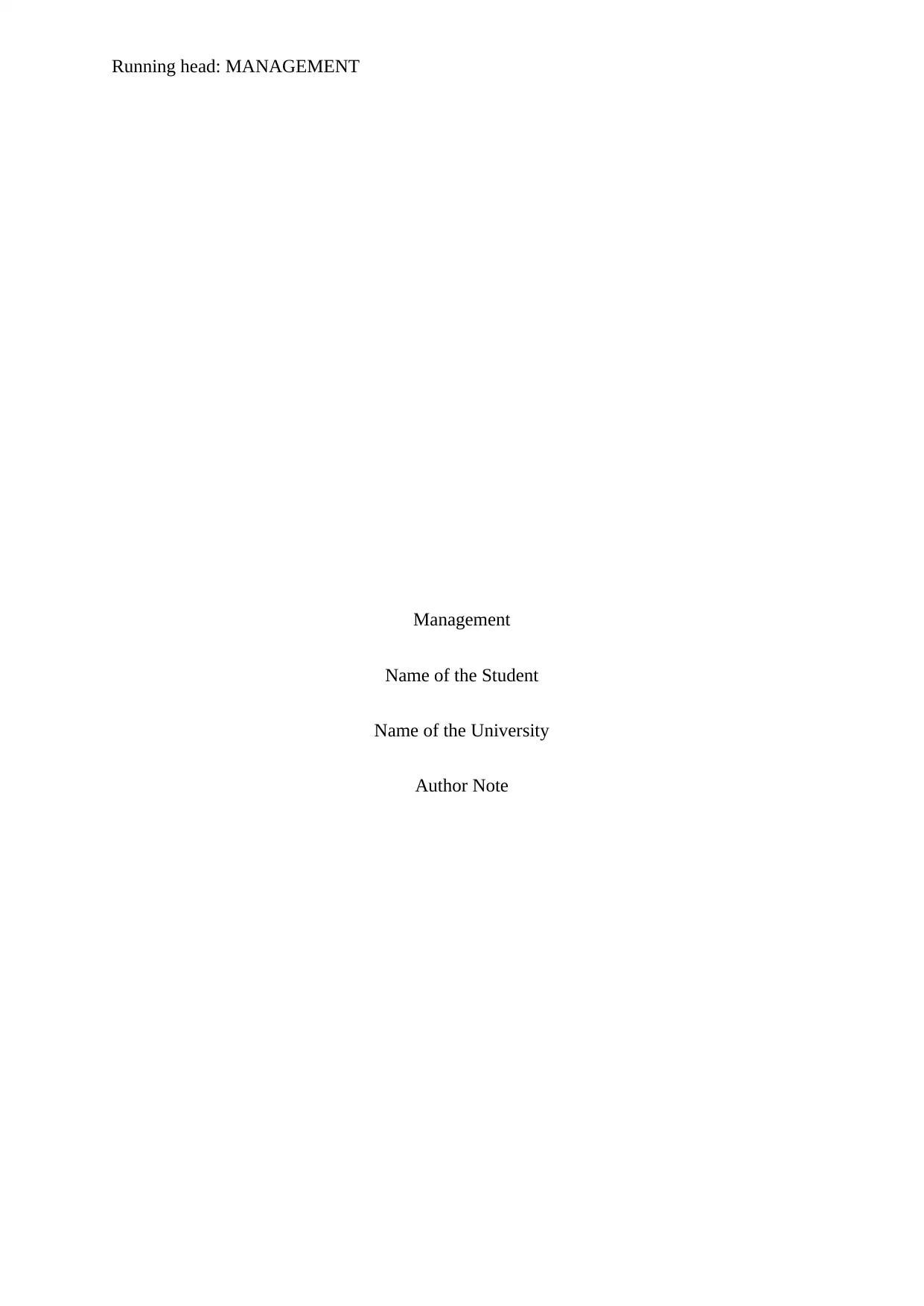
Running head: MANAGEMENT
Management
Name of the Student
Name of the University
Author Note
Management
Name of the Student
Name of the University
Author Note
Secure Best Marks with AI Grader
Need help grading? Try our AI Grader for instant feedback on your assignments.
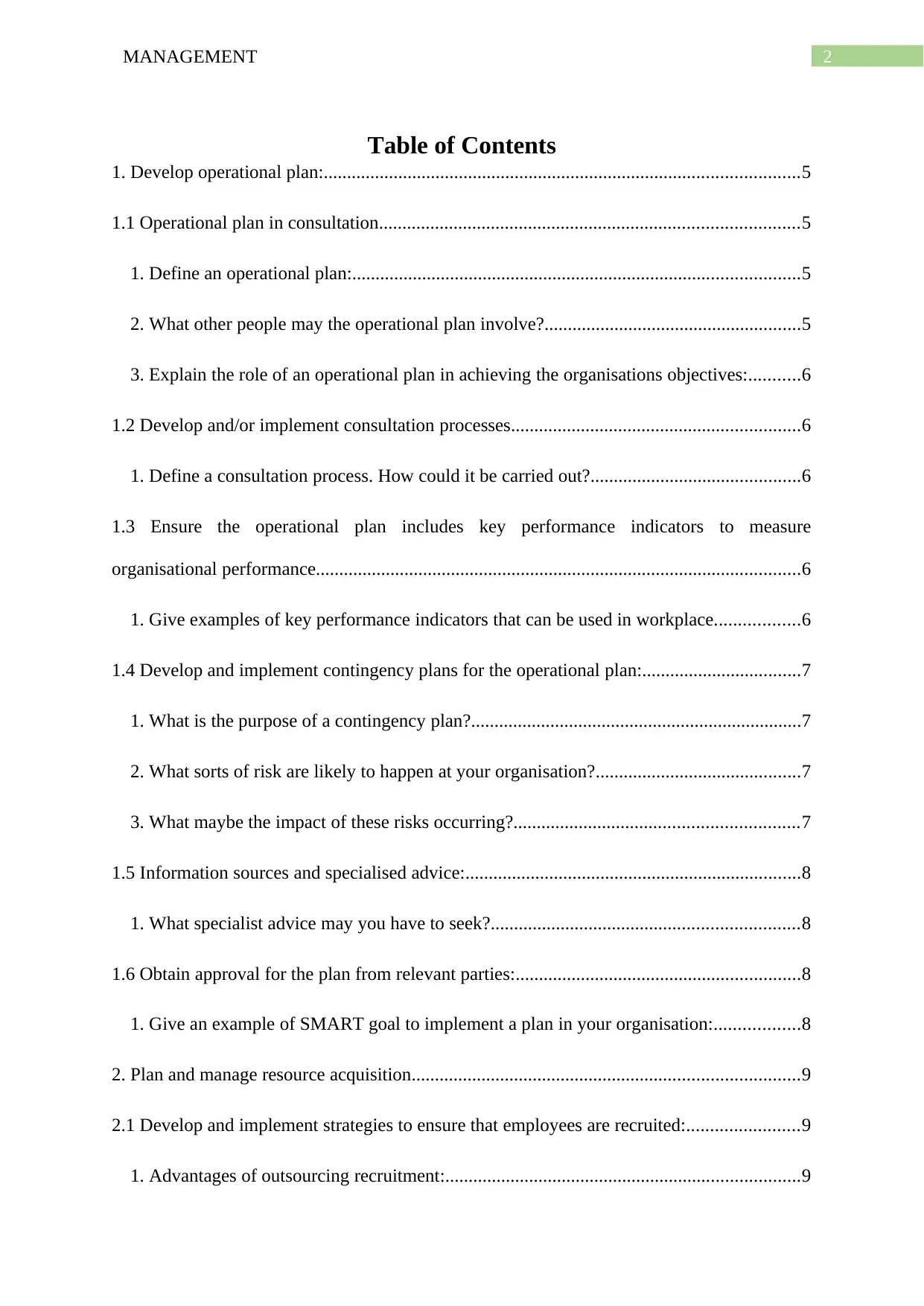
2MANAGEMENT
Table of Contents
1. Develop operational plan:......................................................................................................5
1.1 Operational plan in consultation..........................................................................................5
1. Define an operational plan:................................................................................................5
2. What other people may the operational plan involve?.......................................................5
3. Explain the role of an operational plan in achieving the organisations objectives:...........6
1.2 Develop and/or implement consultation processes..............................................................6
1. Define a consultation process. How could it be carried out?.............................................6
1.3 Ensure the operational plan includes key performance indicators to measure
organisational performance........................................................................................................6
1. Give examples of key performance indicators that can be used in workplace..................6
1.4 Develop and implement contingency plans for the operational plan:..................................7
1. What is the purpose of a contingency plan?.......................................................................7
2. What sorts of risk are likely to happen at your organisation?............................................7
3. What maybe the impact of these risks occurring?.............................................................7
1.5 Information sources and specialised advice:........................................................................8
1. What specialist advice may you have to seek?..................................................................8
1.6 Obtain approval for the plan from relevant parties:.............................................................8
1. Give an example of SMART goal to implement a plan in your organisation:..................8
2. Plan and manage resource acquisition...................................................................................9
2.1 Develop and implement strategies to ensure that employees are recruited:........................9
1. Advantages of outsourcing recruitment:............................................................................9
Table of Contents
1. Develop operational plan:......................................................................................................5
1.1 Operational plan in consultation..........................................................................................5
1. Define an operational plan:................................................................................................5
2. What other people may the operational plan involve?.......................................................5
3. Explain the role of an operational plan in achieving the organisations objectives:...........6
1.2 Develop and/or implement consultation processes..............................................................6
1. Define a consultation process. How could it be carried out?.............................................6
1.3 Ensure the operational plan includes key performance indicators to measure
organisational performance........................................................................................................6
1. Give examples of key performance indicators that can be used in workplace..................6
1.4 Develop and implement contingency plans for the operational plan:..................................7
1. What is the purpose of a contingency plan?.......................................................................7
2. What sorts of risk are likely to happen at your organisation?............................................7
3. What maybe the impact of these risks occurring?.............................................................7
1.5 Information sources and specialised advice:........................................................................8
1. What specialist advice may you have to seek?..................................................................8
1.6 Obtain approval for the plan from relevant parties:.............................................................8
1. Give an example of SMART goal to implement a plan in your organisation:..................8
2. Plan and manage resource acquisition...................................................................................9
2.1 Develop and implement strategies to ensure that employees are recruited:........................9
1. Advantages of outsourcing recruitment:............................................................................9
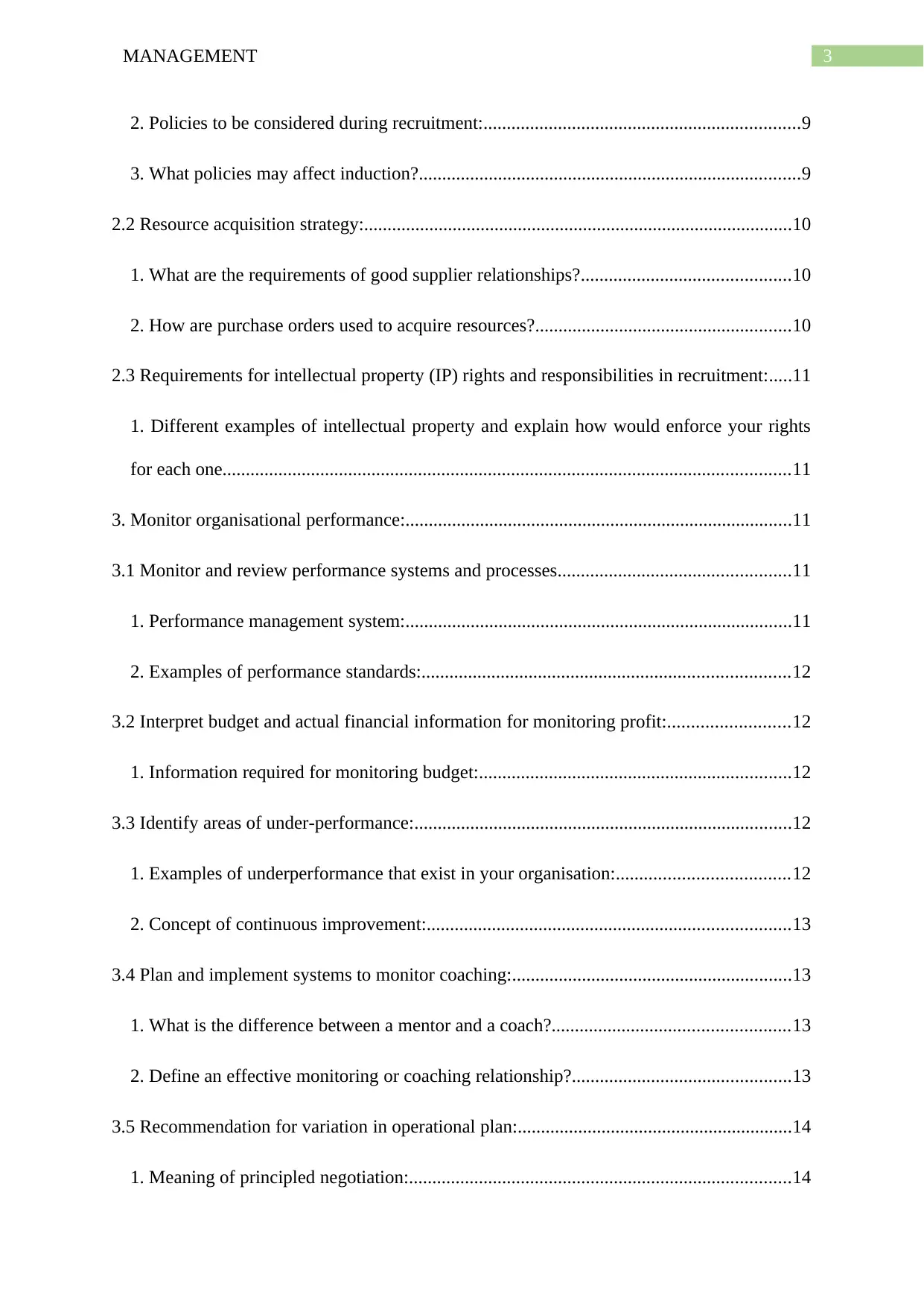
3MANAGEMENT
2. Policies to be considered during recruitment:....................................................................9
3. What policies may affect induction?..................................................................................9
2.2 Resource acquisition strategy:............................................................................................10
1. What are the requirements of good supplier relationships?.............................................10
2. How are purchase orders used to acquire resources?.......................................................10
2.3 Requirements for intellectual property (IP) rights and responsibilities in recruitment:.....11
1. Different examples of intellectual property and explain how would enforce your rights
for each one..........................................................................................................................11
3. Monitor organisational performance:...................................................................................11
3.1 Monitor and review performance systems and processes..................................................11
1. Performance management system:...................................................................................11
2. Examples of performance standards:...............................................................................12
3.2 Interpret budget and actual financial information for monitoring profit:..........................12
1. Information required for monitoring budget:...................................................................12
3.3 Identify areas of under-performance:.................................................................................12
1. Examples of underperformance that exist in your organisation:.....................................12
2. Concept of continuous improvement:..............................................................................13
3.4 Plan and implement systems to monitor coaching:............................................................13
1. What is the difference between a mentor and a coach?...................................................13
2. Define an effective monitoring or coaching relationship?...............................................13
3.5 Recommendation for variation in operational plan:...........................................................14
1. Meaning of principled negotiation:..................................................................................14
2. Policies to be considered during recruitment:....................................................................9
3. What policies may affect induction?..................................................................................9
2.2 Resource acquisition strategy:............................................................................................10
1. What are the requirements of good supplier relationships?.............................................10
2. How are purchase orders used to acquire resources?.......................................................10
2.3 Requirements for intellectual property (IP) rights and responsibilities in recruitment:.....11
1. Different examples of intellectual property and explain how would enforce your rights
for each one..........................................................................................................................11
3. Monitor organisational performance:...................................................................................11
3.1 Monitor and review performance systems and processes..................................................11
1. Performance management system:...................................................................................11
2. Examples of performance standards:...............................................................................12
3.2 Interpret budget and actual financial information for monitoring profit:..........................12
1. Information required for monitoring budget:...................................................................12
3.3 Identify areas of under-performance:.................................................................................12
1. Examples of underperformance that exist in your organisation:.....................................12
2. Concept of continuous improvement:..............................................................................13
3.4 Plan and implement systems to monitor coaching:............................................................13
1. What is the difference between a mentor and a coach?...................................................13
2. Define an effective monitoring or coaching relationship?...............................................13
3.5 Recommendation for variation in operational plan:...........................................................14
1. Meaning of principled negotiation:..................................................................................14
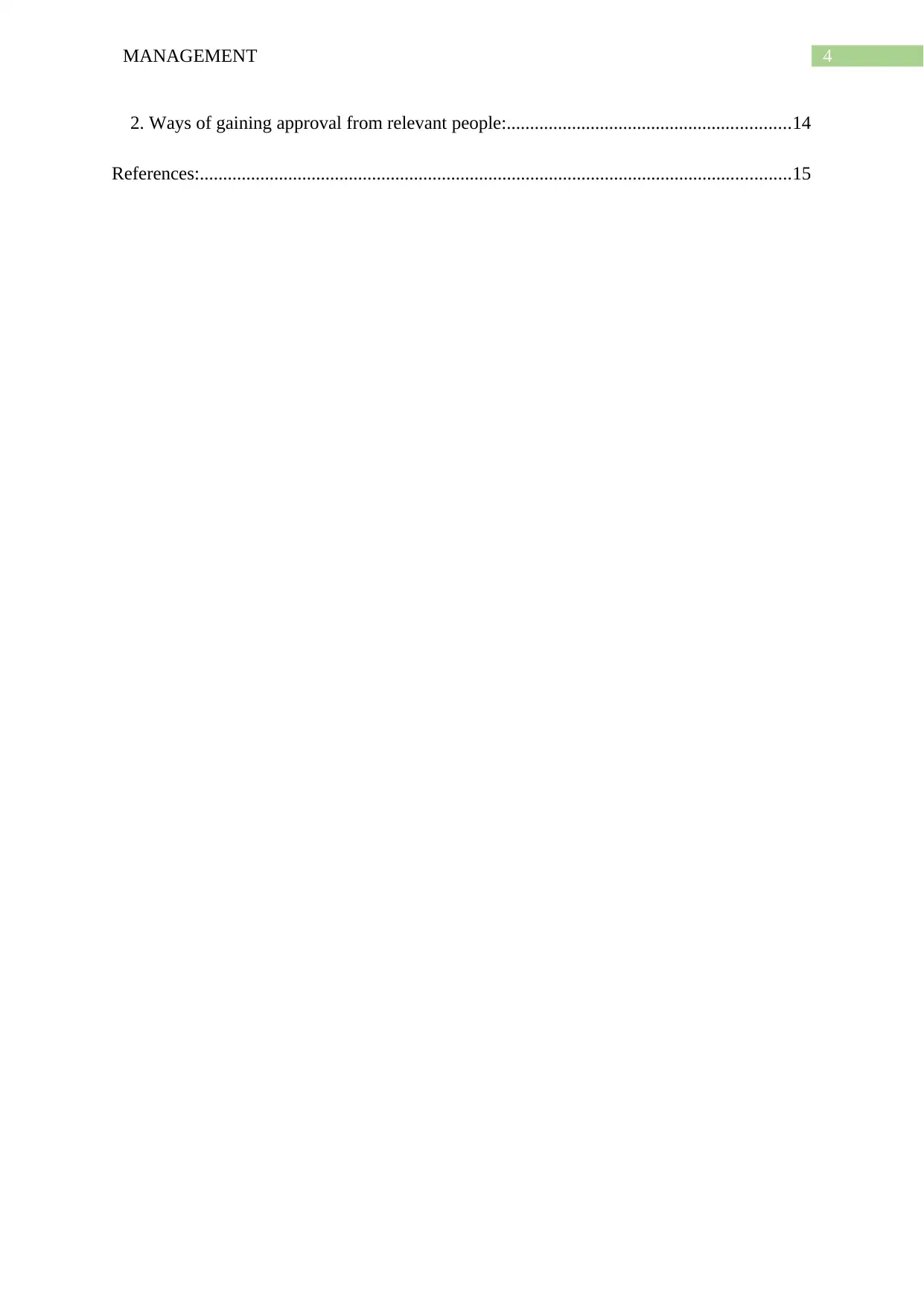
4MANAGEMENT
2. Ways of gaining approval from relevant people:.............................................................14
References:...............................................................................................................................15
2. Ways of gaining approval from relevant people:.............................................................14
References:...............................................................................................................................15
Secure Best Marks with AI Grader
Need help grading? Try our AI Grader for instant feedback on your assignments.

5MANAGEMENT
1. Develop operational plan:
1.1 Operational plan in consultation
1. Define an operational plan:
An operational plan is defined as the detailed plan, which offers a clear picture
regarding the way, through which a team, section and department of an organisation can
achieve the organisational goal. This plan comprises of the activities, which are to be
performed by the organisation on daily basis (Ansoff, et al. 2018). Strategic plan, important
goal, leading indicators, KPIs and communication are some of the majors to be developed
during the development of operational plan.
2. What other people may the operational plan involve?
The fundamental purpose of operational plan is to offer the organisation with clear
picture regarding their roles and responsibilities. The people, who are to be involved in
operational plan are as follows:
Operation manager
Quality control manager
Office manager
Supervisor and lead person
Marketing manager
Purchasing manager
Shopping manager
Professional staffs
1. Develop operational plan:
1.1 Operational plan in consultation
1. Define an operational plan:
An operational plan is defined as the detailed plan, which offers a clear picture
regarding the way, through which a team, section and department of an organisation can
achieve the organisational goal. This plan comprises of the activities, which are to be
performed by the organisation on daily basis (Ansoff, et al. 2018). Strategic plan, important
goal, leading indicators, KPIs and communication are some of the majors to be developed
during the development of operational plan.
2. What other people may the operational plan involve?
The fundamental purpose of operational plan is to offer the organisation with clear
picture regarding their roles and responsibilities. The people, who are to be involved in
operational plan are as follows:
Operation manager
Quality control manager
Office manager
Supervisor and lead person
Marketing manager
Purchasing manager
Shopping manager
Professional staffs
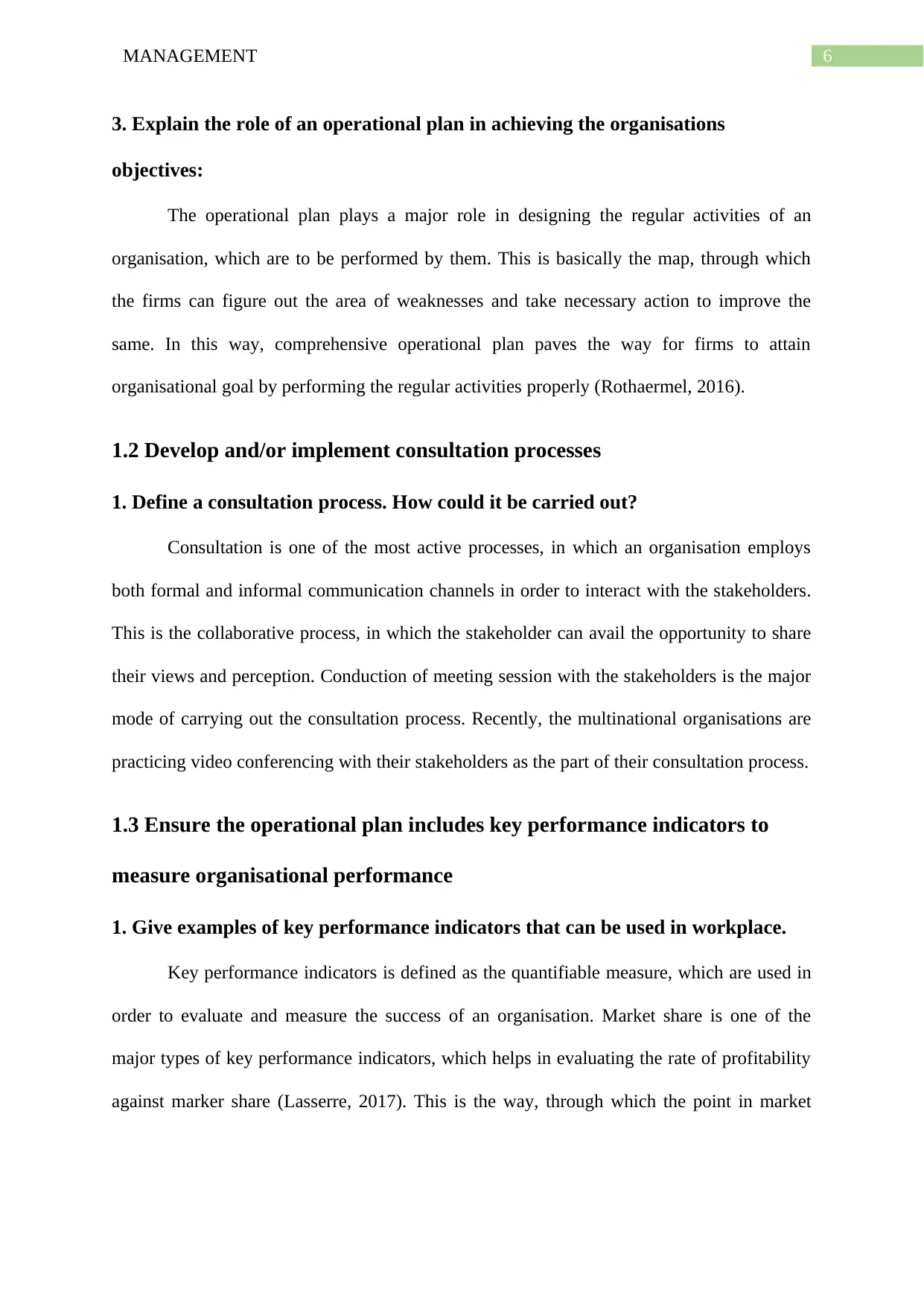
6MANAGEMENT
3. Explain the role of an operational plan in achieving the organisations
objectives:
The operational plan plays a major role in designing the regular activities of an
organisation, which are to be performed by them. This is basically the map, through which
the firms can figure out the area of weaknesses and take necessary action to improve the
same. In this way, comprehensive operational plan paves the way for firms to attain
organisational goal by performing the regular activities properly (Rothaermel, 2016).
1.2 Develop and/or implement consultation processes
1. Define a consultation process. How could it be carried out?
Consultation is one of the most active processes, in which an organisation employs
both formal and informal communication channels in order to interact with the stakeholders.
This is the collaborative process, in which the stakeholder can avail the opportunity to share
their views and perception. Conduction of meeting session with the stakeholders is the major
mode of carrying out the consultation process. Recently, the multinational organisations are
practicing video conferencing with their stakeholders as the part of their consultation process.
1.3 Ensure the operational plan includes key performance indicators to
measure organisational performance
1. Give examples of key performance indicators that can be used in workplace.
Key performance indicators is defined as the quantifiable measure, which are used in
order to evaluate and measure the success of an organisation. Market share is one of the
major types of key performance indicators, which helps in evaluating the rate of profitability
against marker share (Lasserre, 2017). This is the way, through which the point in market
3. Explain the role of an operational plan in achieving the organisations
objectives:
The operational plan plays a major role in designing the regular activities of an
organisation, which are to be performed by them. This is basically the map, through which
the firms can figure out the area of weaknesses and take necessary action to improve the
same. In this way, comprehensive operational plan paves the way for firms to attain
organisational goal by performing the regular activities properly (Rothaermel, 2016).
1.2 Develop and/or implement consultation processes
1. Define a consultation process. How could it be carried out?
Consultation is one of the most active processes, in which an organisation employs
both formal and informal communication channels in order to interact with the stakeholders.
This is the collaborative process, in which the stakeholder can avail the opportunity to share
their views and perception. Conduction of meeting session with the stakeholders is the major
mode of carrying out the consultation process. Recently, the multinational organisations are
practicing video conferencing with their stakeholders as the part of their consultation process.
1.3 Ensure the operational plan includes key performance indicators to
measure organisational performance
1. Give examples of key performance indicators that can be used in workplace.
Key performance indicators is defined as the quantifiable measure, which are used in
order to evaluate and measure the success of an organisation. Market share is one of the
major types of key performance indicators, which helps in evaluating the rate of profitability
against marker share (Lasserre, 2017). This is the way, through which the point in market
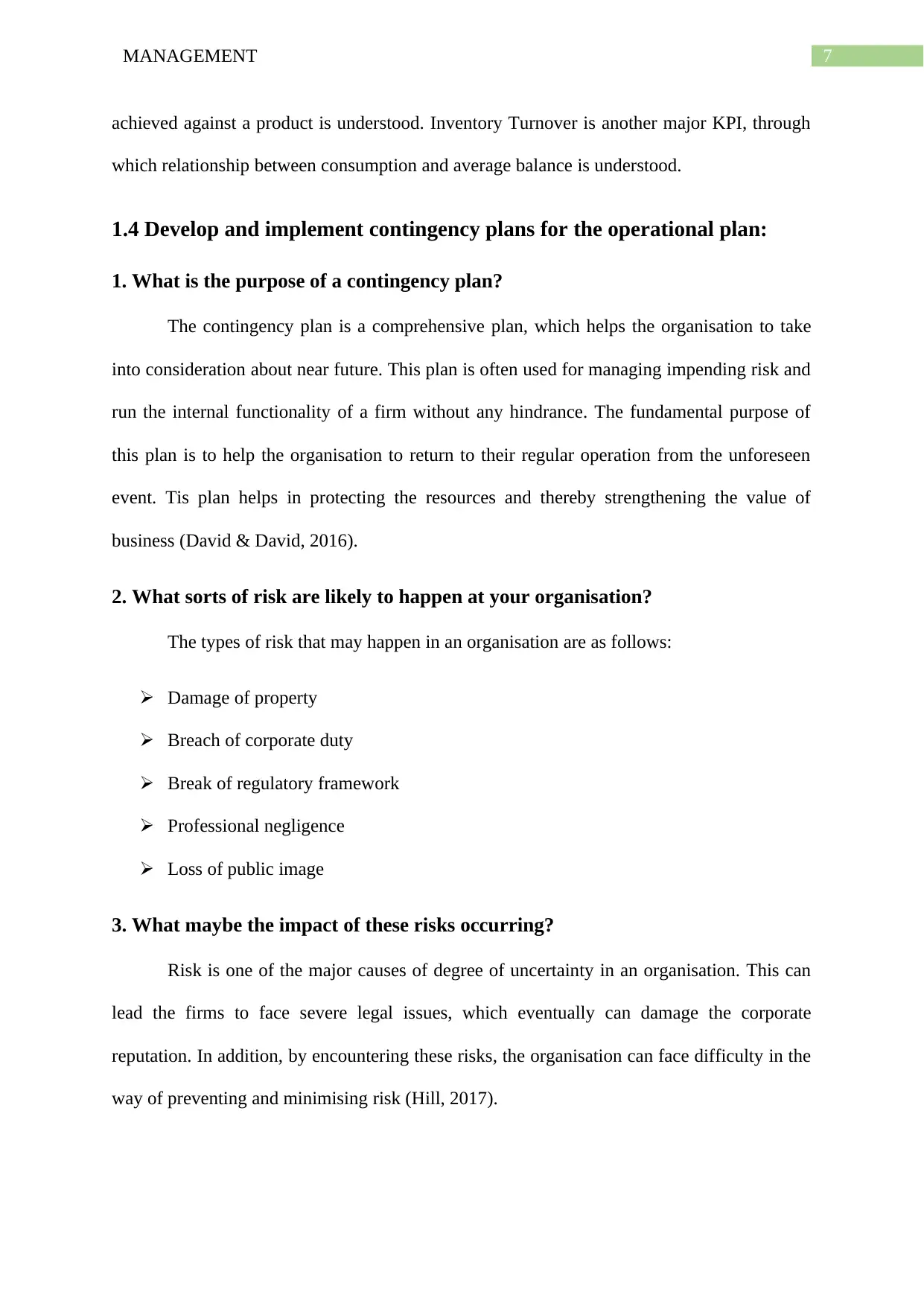
7MANAGEMENT
achieved against a product is understood. Inventory Turnover is another major KPI, through
which relationship between consumption and average balance is understood.
1.4 Develop and implement contingency plans for the operational plan:
1. What is the purpose of a contingency plan?
The contingency plan is a comprehensive plan, which helps the organisation to take
into consideration about near future. This plan is often used for managing impending risk and
run the internal functionality of a firm without any hindrance. The fundamental purpose of
this plan is to help the organisation to return to their regular operation from the unforeseen
event. Tis plan helps in protecting the resources and thereby strengthening the value of
business (David & David, 2016).
2. What sorts of risk are likely to happen at your organisation?
The types of risk that may happen in an organisation are as follows:
Damage of property
Breach of corporate duty
Break of regulatory framework
Professional negligence
Loss of public image
3. What maybe the impact of these risks occurring?
Risk is one of the major causes of degree of uncertainty in an organisation. This can
lead the firms to face severe legal issues, which eventually can damage the corporate
reputation. In addition, by encountering these risks, the organisation can face difficulty in the
way of preventing and minimising risk (Hill, 2017).
achieved against a product is understood. Inventory Turnover is another major KPI, through
which relationship between consumption and average balance is understood.
1.4 Develop and implement contingency plans for the operational plan:
1. What is the purpose of a contingency plan?
The contingency plan is a comprehensive plan, which helps the organisation to take
into consideration about near future. This plan is often used for managing impending risk and
run the internal functionality of a firm without any hindrance. The fundamental purpose of
this plan is to help the organisation to return to their regular operation from the unforeseen
event. Tis plan helps in protecting the resources and thereby strengthening the value of
business (David & David, 2016).
2. What sorts of risk are likely to happen at your organisation?
The types of risk that may happen in an organisation are as follows:
Damage of property
Breach of corporate duty
Break of regulatory framework
Professional negligence
Loss of public image
3. What maybe the impact of these risks occurring?
Risk is one of the major causes of degree of uncertainty in an organisation. This can
lead the firms to face severe legal issues, which eventually can damage the corporate
reputation. In addition, by encountering these risks, the organisation can face difficulty in the
way of preventing and minimising risk (Hill, 2017).
Paraphrase This Document
Need a fresh take? Get an instant paraphrase of this document with our AI Paraphraser
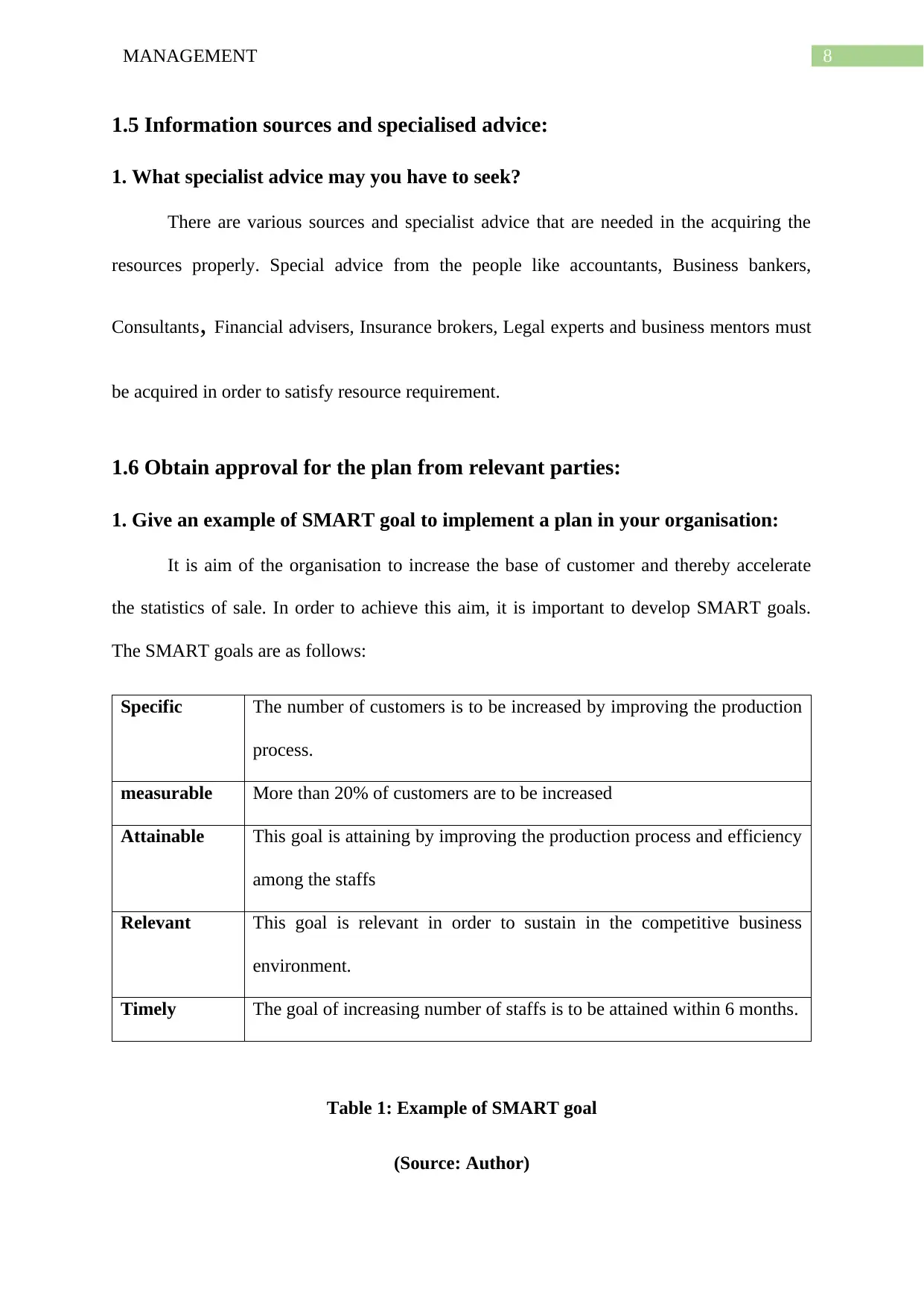
8MANAGEMENT
1.5 Information sources and specialised advice:
1. What specialist advice may you have to seek?
There are various sources and specialist advice that are needed in the acquiring the
resources properly. Special advice from the people like accountants, Business bankers,
Consultants, Financial advisers, Insurance brokers, Legal experts and business mentors must
be acquired in order to satisfy resource requirement.
1.6 Obtain approval for the plan from relevant parties:
1. Give an example of SMART goal to implement a plan in your organisation:
It is aim of the organisation to increase the base of customer and thereby accelerate
the statistics of sale. In order to achieve this aim, it is important to develop SMART goals.
The SMART goals are as follows:
Specific The number of customers is to be increased by improving the production
process.
measurable More than 20% of customers are to be increased
Attainable This goal is attaining by improving the production process and efficiency
among the staffs
Relevant This goal is relevant in order to sustain in the competitive business
environment.
Timely The goal of increasing number of staffs is to be attained within 6 months.
Table 1: Example of SMART goal
(Source: Author)
1.5 Information sources and specialised advice:
1. What specialist advice may you have to seek?
There are various sources and specialist advice that are needed in the acquiring the
resources properly. Special advice from the people like accountants, Business bankers,
Consultants, Financial advisers, Insurance brokers, Legal experts and business mentors must
be acquired in order to satisfy resource requirement.
1.6 Obtain approval for the plan from relevant parties:
1. Give an example of SMART goal to implement a plan in your organisation:
It is aim of the organisation to increase the base of customer and thereby accelerate
the statistics of sale. In order to achieve this aim, it is important to develop SMART goals.
The SMART goals are as follows:
Specific The number of customers is to be increased by improving the production
process.
measurable More than 20% of customers are to be increased
Attainable This goal is attaining by improving the production process and efficiency
among the staffs
Relevant This goal is relevant in order to sustain in the competitive business
environment.
Timely The goal of increasing number of staffs is to be attained within 6 months.
Table 1: Example of SMART goal
(Source: Author)
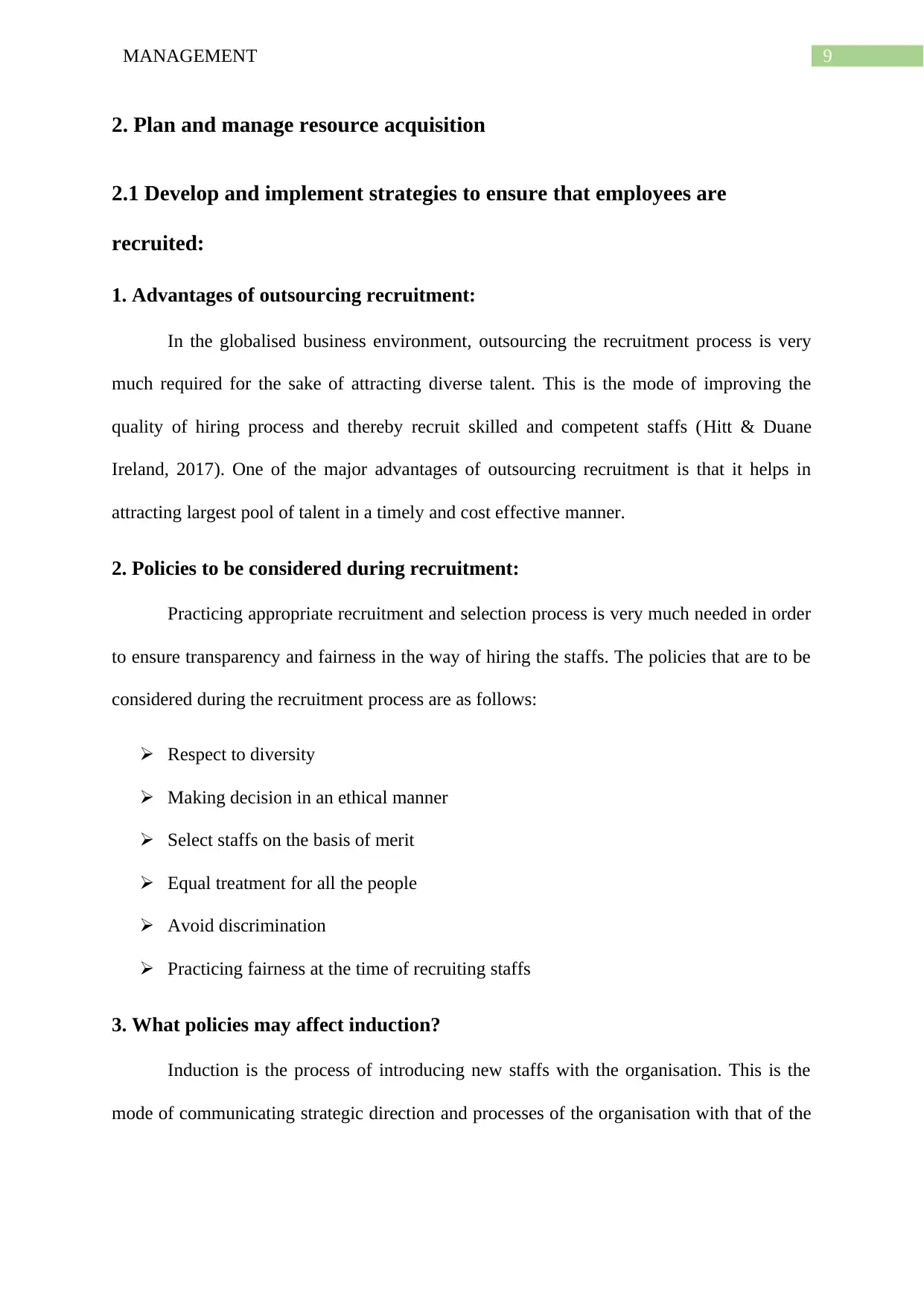
9MANAGEMENT
2. Plan and manage resource acquisition
2.1 Develop and implement strategies to ensure that employees are
recruited:
1. Advantages of outsourcing recruitment:
In the globalised business environment, outsourcing the recruitment process is very
much required for the sake of attracting diverse talent. This is the mode of improving the
quality of hiring process and thereby recruit skilled and competent staffs (Hitt & Duane
Ireland, 2017). One of the major advantages of outsourcing recruitment is that it helps in
attracting largest pool of talent in a timely and cost effective manner.
2. Policies to be considered during recruitment:
Practicing appropriate recruitment and selection process is very much needed in order
to ensure transparency and fairness in the way of hiring the staffs. The policies that are to be
considered during the recruitment process are as follows:
Respect to diversity
Making decision in an ethical manner
Select staffs on the basis of merit
Equal treatment for all the people
Avoid discrimination
Practicing fairness at the time of recruiting staffs
3. What policies may affect induction?
Induction is the process of introducing new staffs with the organisation. This is the
mode of communicating strategic direction and processes of the organisation with that of the
2. Plan and manage resource acquisition
2.1 Develop and implement strategies to ensure that employees are
recruited:
1. Advantages of outsourcing recruitment:
In the globalised business environment, outsourcing the recruitment process is very
much required for the sake of attracting diverse talent. This is the mode of improving the
quality of hiring process and thereby recruit skilled and competent staffs (Hitt & Duane
Ireland, 2017). One of the major advantages of outsourcing recruitment is that it helps in
attracting largest pool of talent in a timely and cost effective manner.
2. Policies to be considered during recruitment:
Practicing appropriate recruitment and selection process is very much needed in order
to ensure transparency and fairness in the way of hiring the staffs. The policies that are to be
considered during the recruitment process are as follows:
Respect to diversity
Making decision in an ethical manner
Select staffs on the basis of merit
Equal treatment for all the people
Avoid discrimination
Practicing fairness at the time of recruiting staffs
3. What policies may affect induction?
Induction is the process of introducing new staffs with the organisation. This is the
mode of communicating strategic direction and processes of the organisation with that of the
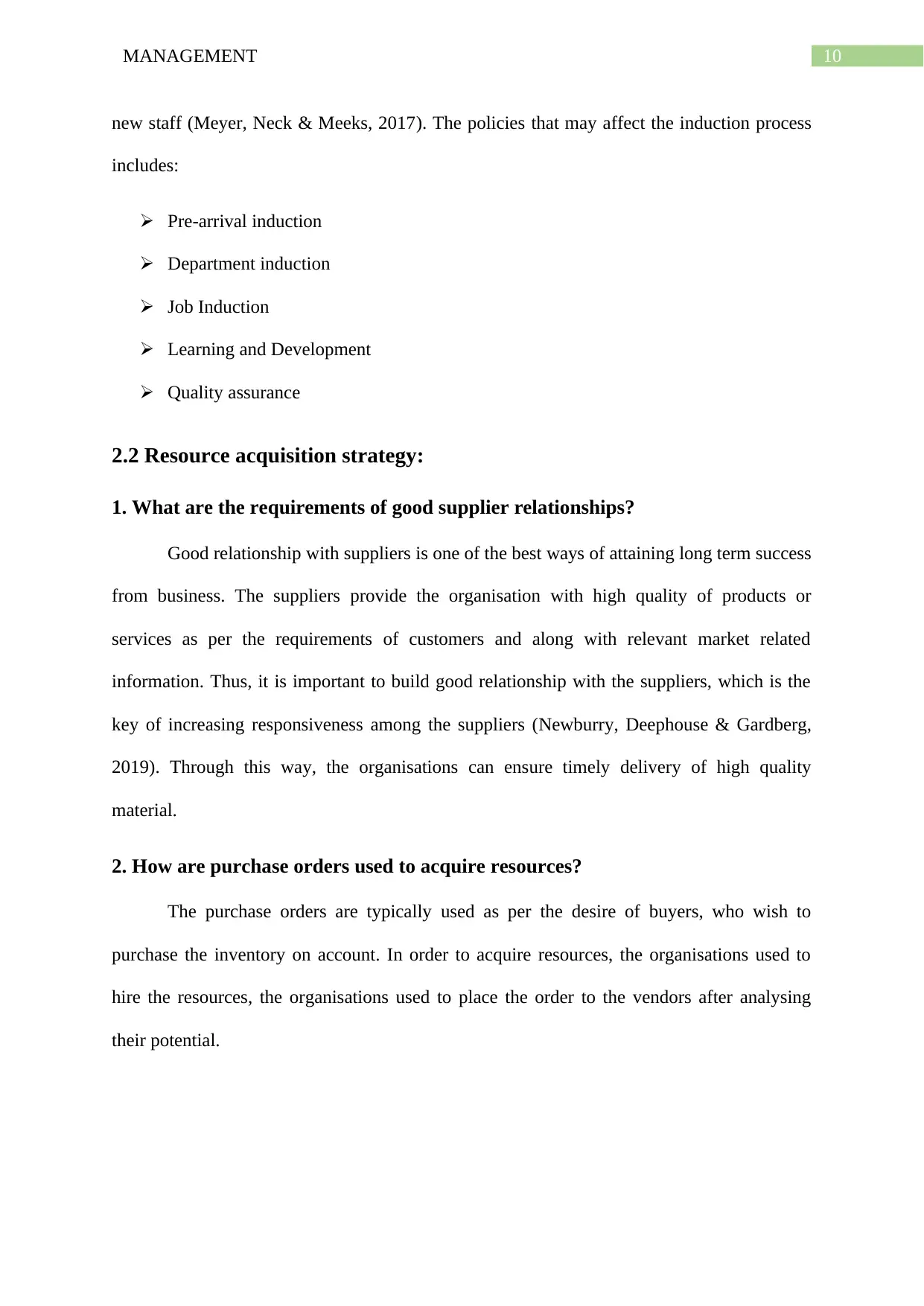
10MANAGEMENT
new staff (Meyer, Neck & Meeks, 2017). The policies that may affect the induction process
includes:
Pre-arrival induction
Department induction
Job Induction
Learning and Development
Quality assurance
2.2 Resource acquisition strategy:
1. What are the requirements of good supplier relationships?
Good relationship with suppliers is one of the best ways of attaining long term success
from business. The suppliers provide the organisation with high quality of products or
services as per the requirements of customers and along with relevant market related
information. Thus, it is important to build good relationship with the suppliers, which is the
key of increasing responsiveness among the suppliers (Newburry, Deephouse & Gardberg,
2019). Through this way, the organisations can ensure timely delivery of high quality
material.
2. How are purchase orders used to acquire resources?
The purchase orders are typically used as per the desire of buyers, who wish to
purchase the inventory on account. In order to acquire resources, the organisations used to
hire the resources, the organisations used to place the order to the vendors after analysing
their potential.
new staff (Meyer, Neck & Meeks, 2017). The policies that may affect the induction process
includes:
Pre-arrival induction
Department induction
Job Induction
Learning and Development
Quality assurance
2.2 Resource acquisition strategy:
1. What are the requirements of good supplier relationships?
Good relationship with suppliers is one of the best ways of attaining long term success
from business. The suppliers provide the organisation with high quality of products or
services as per the requirements of customers and along with relevant market related
information. Thus, it is important to build good relationship with the suppliers, which is the
key of increasing responsiveness among the suppliers (Newburry, Deephouse & Gardberg,
2019). Through this way, the organisations can ensure timely delivery of high quality
material.
2. How are purchase orders used to acquire resources?
The purchase orders are typically used as per the desire of buyers, who wish to
purchase the inventory on account. In order to acquire resources, the organisations used to
hire the resources, the organisations used to place the order to the vendors after analysing
their potential.
Secure Best Marks with AI Grader
Need help grading? Try our AI Grader for instant feedback on your assignments.
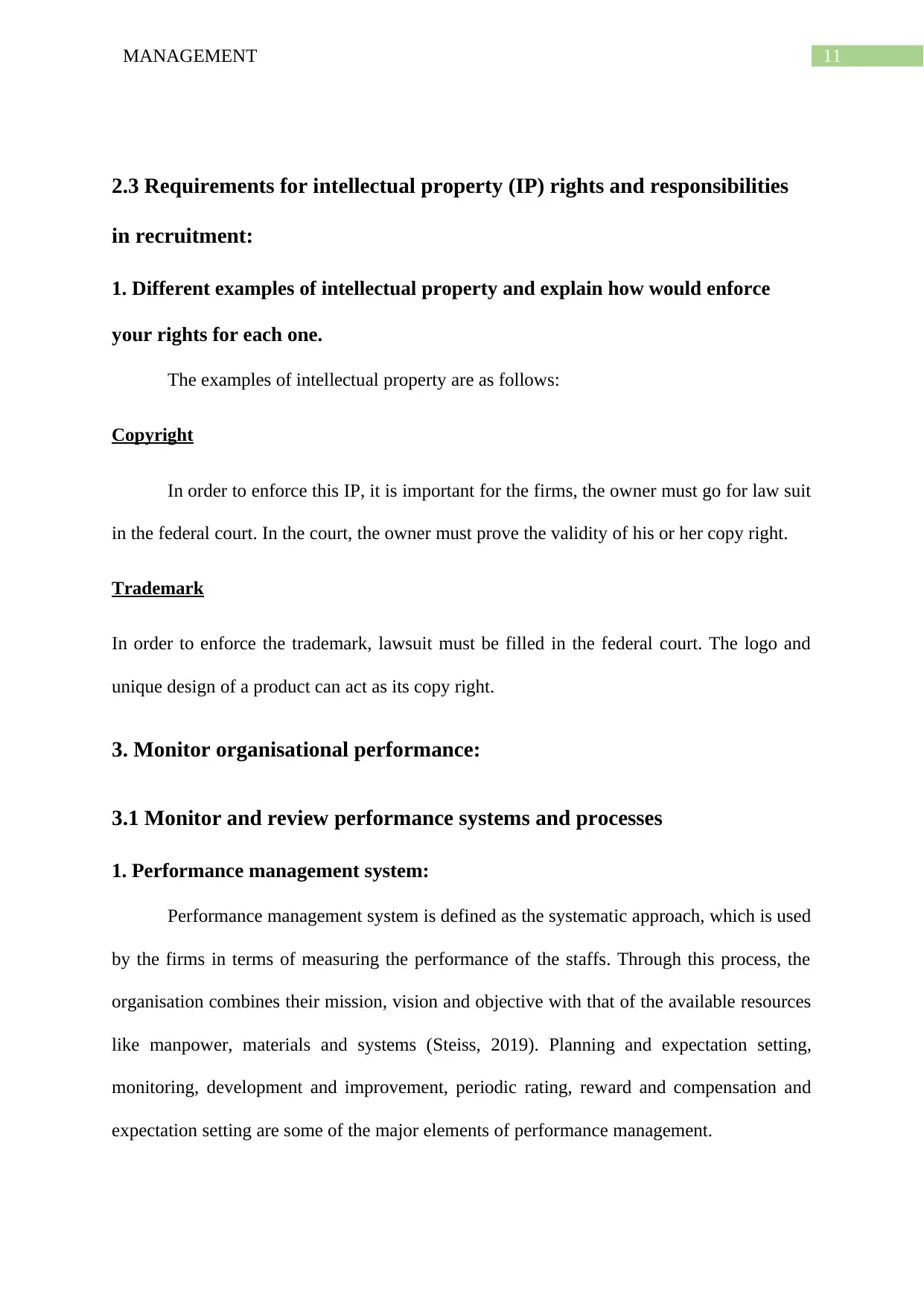
11MANAGEMENT
2.3 Requirements for intellectual property (IP) rights and responsibilities
in recruitment:
1. Different examples of intellectual property and explain how would enforce
your rights for each one.
The examples of intellectual property are as follows:
Copyright
In order to enforce this IP, it is important for the firms, the owner must go for law suit
in the federal court. In the court, the owner must prove the validity of his or her copy right.
Trademark
In order to enforce the trademark, lawsuit must be filled in the federal court. The logo and
unique design of a product can act as its copy right.
3. Monitor organisational performance:
3.1 Monitor and review performance systems and processes
1. Performance management system:
Performance management system is defined as the systematic approach, which is used
by the firms in terms of measuring the performance of the staffs. Through this process, the
organisation combines their mission, vision and objective with that of the available resources
like manpower, materials and systems (Steiss, 2019). Planning and expectation setting,
monitoring, development and improvement, periodic rating, reward and compensation and
expectation setting are some of the major elements of performance management.
2.3 Requirements for intellectual property (IP) rights and responsibilities
in recruitment:
1. Different examples of intellectual property and explain how would enforce
your rights for each one.
The examples of intellectual property are as follows:
Copyright
In order to enforce this IP, it is important for the firms, the owner must go for law suit
in the federal court. In the court, the owner must prove the validity of his or her copy right.
Trademark
In order to enforce the trademark, lawsuit must be filled in the federal court. The logo and
unique design of a product can act as its copy right.
3. Monitor organisational performance:
3.1 Monitor and review performance systems and processes
1. Performance management system:
Performance management system is defined as the systematic approach, which is used
by the firms in terms of measuring the performance of the staffs. Through this process, the
organisation combines their mission, vision and objective with that of the available resources
like manpower, materials and systems (Steiss, 2019). Planning and expectation setting,
monitoring, development and improvement, periodic rating, reward and compensation and
expectation setting are some of the major elements of performance management.
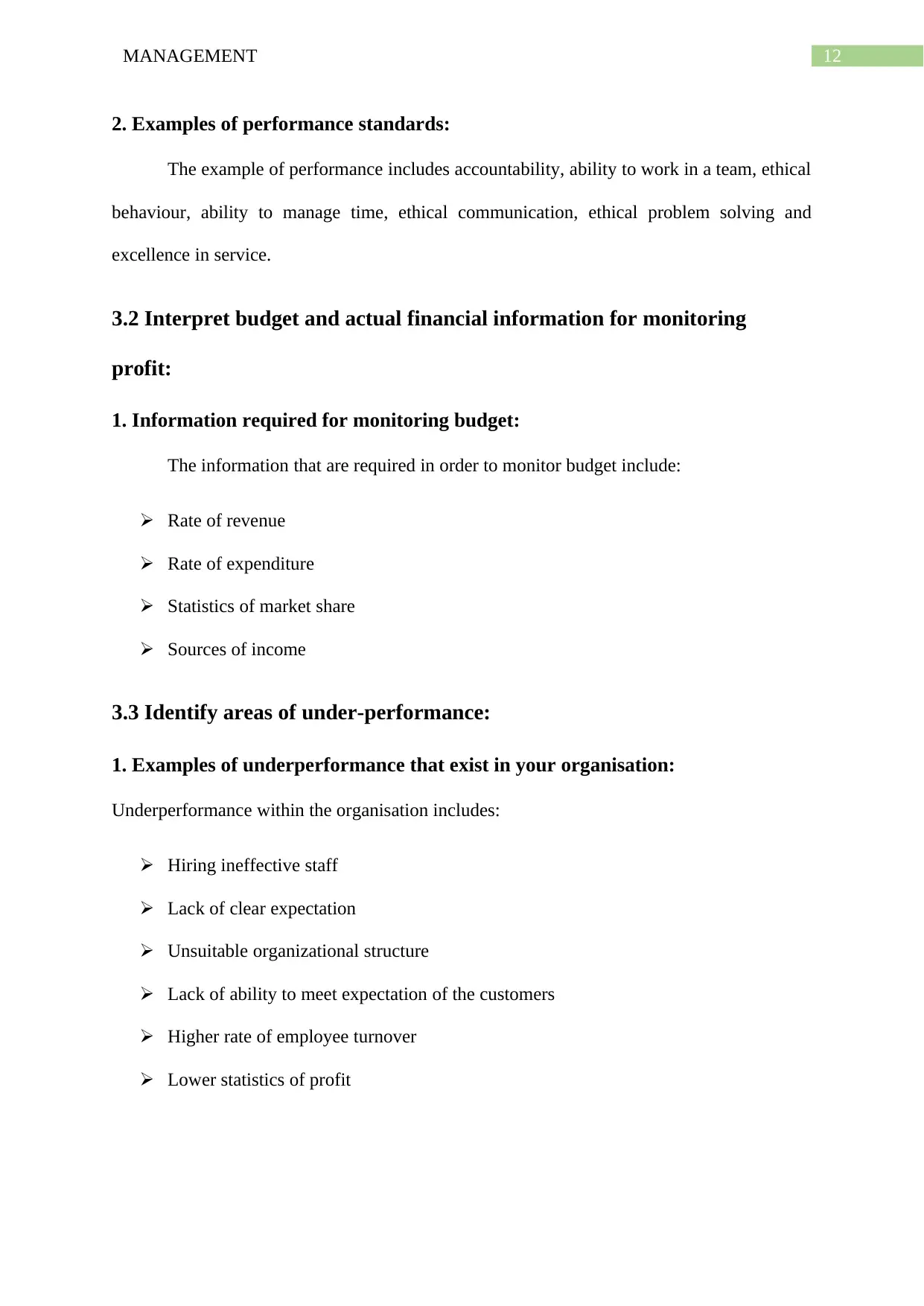
12MANAGEMENT
2. Examples of performance standards:
The example of performance includes accountability, ability to work in a team, ethical
behaviour, ability to manage time, ethical communication, ethical problem solving and
excellence in service.
3.2 Interpret budget and actual financial information for monitoring
profit:
1. Information required for monitoring budget:
The information that are required in order to monitor budget include:
Rate of revenue
Rate of expenditure
Statistics of market share
Sources of income
3.3 Identify areas of under-performance:
1. Examples of underperformance that exist in your organisation:
Underperformance within the organisation includes:
Hiring ineffective staff
Lack of clear expectation
Unsuitable organizational structure
Lack of ability to meet expectation of the customers
Higher rate of employee turnover
Lower statistics of profit
2. Examples of performance standards:
The example of performance includes accountability, ability to work in a team, ethical
behaviour, ability to manage time, ethical communication, ethical problem solving and
excellence in service.
3.2 Interpret budget and actual financial information for monitoring
profit:
1. Information required for monitoring budget:
The information that are required in order to monitor budget include:
Rate of revenue
Rate of expenditure
Statistics of market share
Sources of income
3.3 Identify areas of under-performance:
1. Examples of underperformance that exist in your organisation:
Underperformance within the organisation includes:
Hiring ineffective staff
Lack of clear expectation
Unsuitable organizational structure
Lack of ability to meet expectation of the customers
Higher rate of employee turnover
Lower statistics of profit
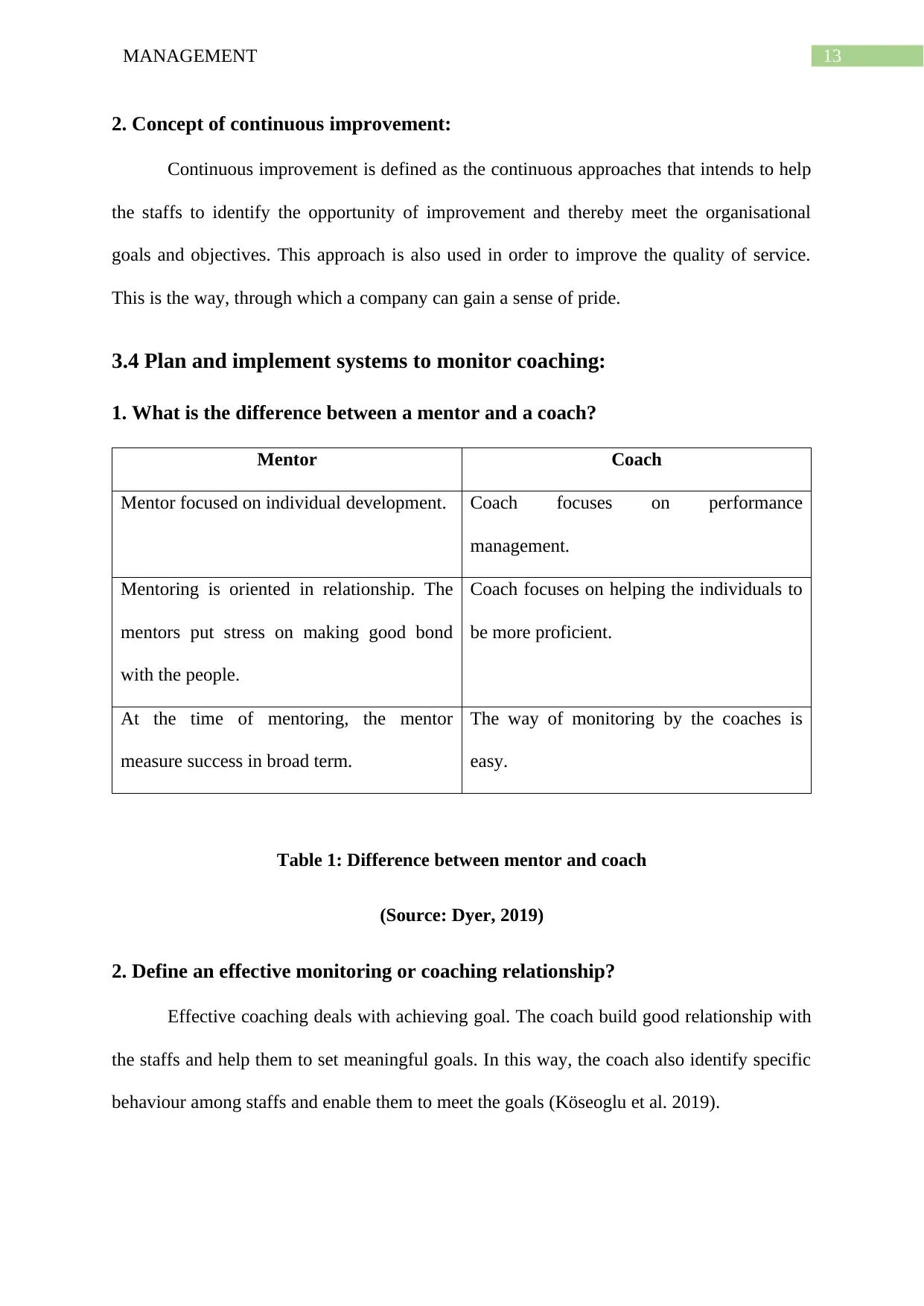
13MANAGEMENT
2. Concept of continuous improvement:
Continuous improvement is defined as the continuous approaches that intends to help
the staffs to identify the opportunity of improvement and thereby meet the organisational
goals and objectives. This approach is also used in order to improve the quality of service.
This is the way, through which a company can gain a sense of pride.
3.4 Plan and implement systems to monitor coaching:
1. What is the difference between a mentor and a coach?
Mentor Coach
Mentor focused on individual development. Coach focuses on performance
management.
Mentoring is oriented in relationship. The
mentors put stress on making good bond
with the people.
Coach focuses on helping the individuals to
be more proficient.
At the time of mentoring, the mentor
measure success in broad term.
The way of monitoring by the coaches is
easy.
Table 1: Difference between mentor and coach
(Source: Dyer, 2019)
2. Define an effective monitoring or coaching relationship?
Effective coaching deals with achieving goal. The coach build good relationship with
the staffs and help them to set meaningful goals. In this way, the coach also identify specific
behaviour among staffs and enable them to meet the goals (Köseoglu et al. 2019).
2. Concept of continuous improvement:
Continuous improvement is defined as the continuous approaches that intends to help
the staffs to identify the opportunity of improvement and thereby meet the organisational
goals and objectives. This approach is also used in order to improve the quality of service.
This is the way, through which a company can gain a sense of pride.
3.4 Plan and implement systems to monitor coaching:
1. What is the difference between a mentor and a coach?
Mentor Coach
Mentor focused on individual development. Coach focuses on performance
management.
Mentoring is oriented in relationship. The
mentors put stress on making good bond
with the people.
Coach focuses on helping the individuals to
be more proficient.
At the time of mentoring, the mentor
measure success in broad term.
The way of monitoring by the coaches is
easy.
Table 1: Difference between mentor and coach
(Source: Dyer, 2019)
2. Define an effective monitoring or coaching relationship?
Effective coaching deals with achieving goal. The coach build good relationship with
the staffs and help them to set meaningful goals. In this way, the coach also identify specific
behaviour among staffs and enable them to meet the goals (Köseoglu et al. 2019).
Paraphrase This Document
Need a fresh take? Get an instant paraphrase of this document with our AI Paraphraser
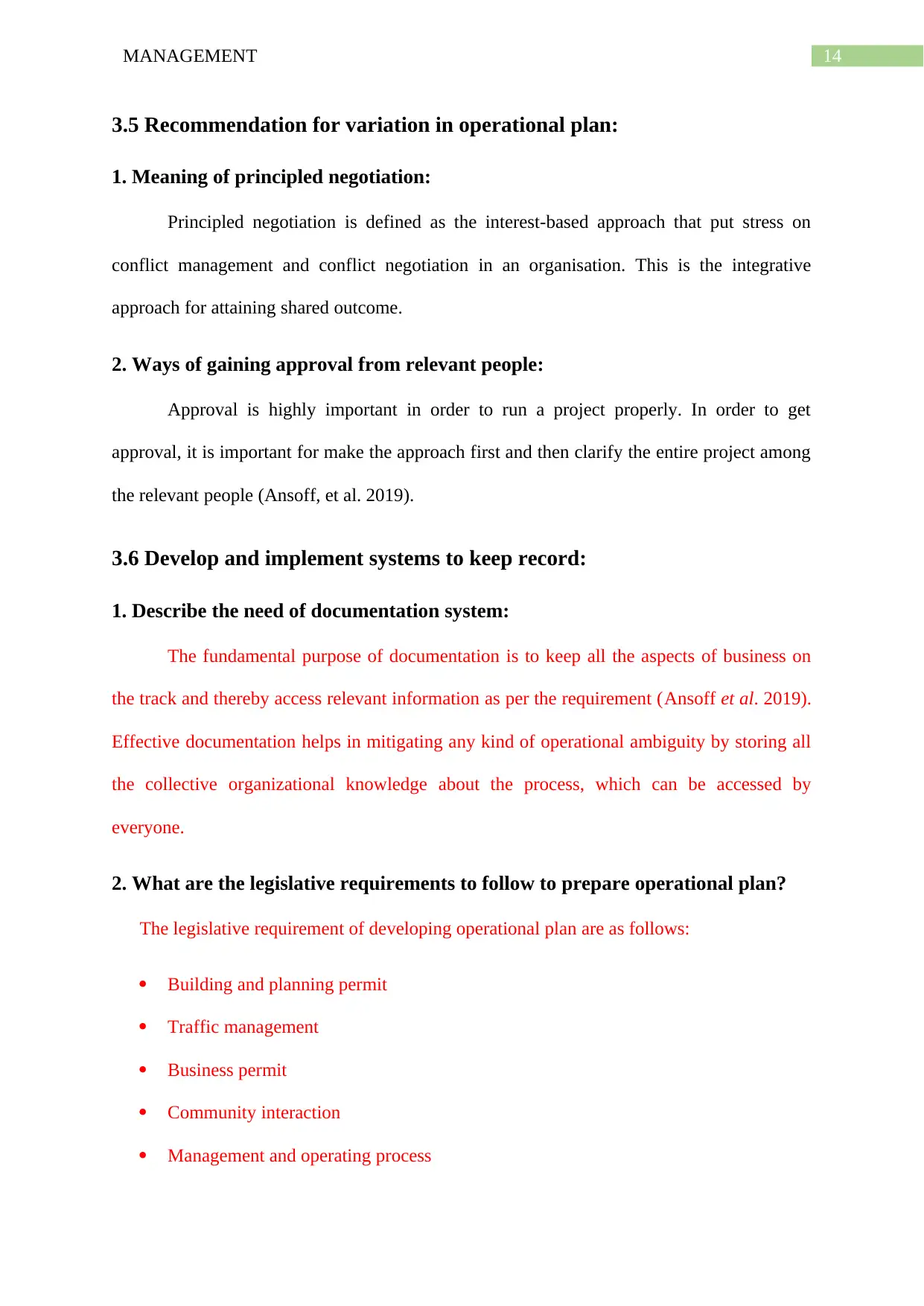
14MANAGEMENT
3.5 Recommendation for variation in operational plan:
1. Meaning of principled negotiation:
Principled negotiation is defined as the interest-based approach that put stress on
conflict management and conflict negotiation in an organisation. This is the integrative
approach for attaining shared outcome.
2. Ways of gaining approval from relevant people:
Approval is highly important in order to run a project properly. In order to get
approval, it is important for make the approach first and then clarify the entire project among
the relevant people (Ansoff, et al. 2019).
3.6 Develop and implement systems to keep record:
1. Describe the need of documentation system:
The fundamental purpose of documentation is to keep all the aspects of business on
the track and thereby access relevant information as per the requirement (Ansoff et al. 2019).
Effective documentation helps in mitigating any kind of operational ambiguity by storing all
the collective organizational knowledge about the process, which can be accessed by
everyone.
2. What are the legislative requirements to follow to prepare operational plan?
The legislative requirement of developing operational plan are as follows:
Building and planning permit
Traffic management
Business permit
Community interaction
Management and operating process
3.5 Recommendation for variation in operational plan:
1. Meaning of principled negotiation:
Principled negotiation is defined as the interest-based approach that put stress on
conflict management and conflict negotiation in an organisation. This is the integrative
approach for attaining shared outcome.
2. Ways of gaining approval from relevant people:
Approval is highly important in order to run a project properly. In order to get
approval, it is important for make the approach first and then clarify the entire project among
the relevant people (Ansoff, et al. 2019).
3.6 Develop and implement systems to keep record:
1. Describe the need of documentation system:
The fundamental purpose of documentation is to keep all the aspects of business on
the track and thereby access relevant information as per the requirement (Ansoff et al. 2019).
Effective documentation helps in mitigating any kind of operational ambiguity by storing all
the collective organizational knowledge about the process, which can be accessed by
everyone.
2. What are the legislative requirements to follow to prepare operational plan?
The legislative requirement of developing operational plan are as follows:
Building and planning permit
Traffic management
Business permit
Community interaction
Management and operating process
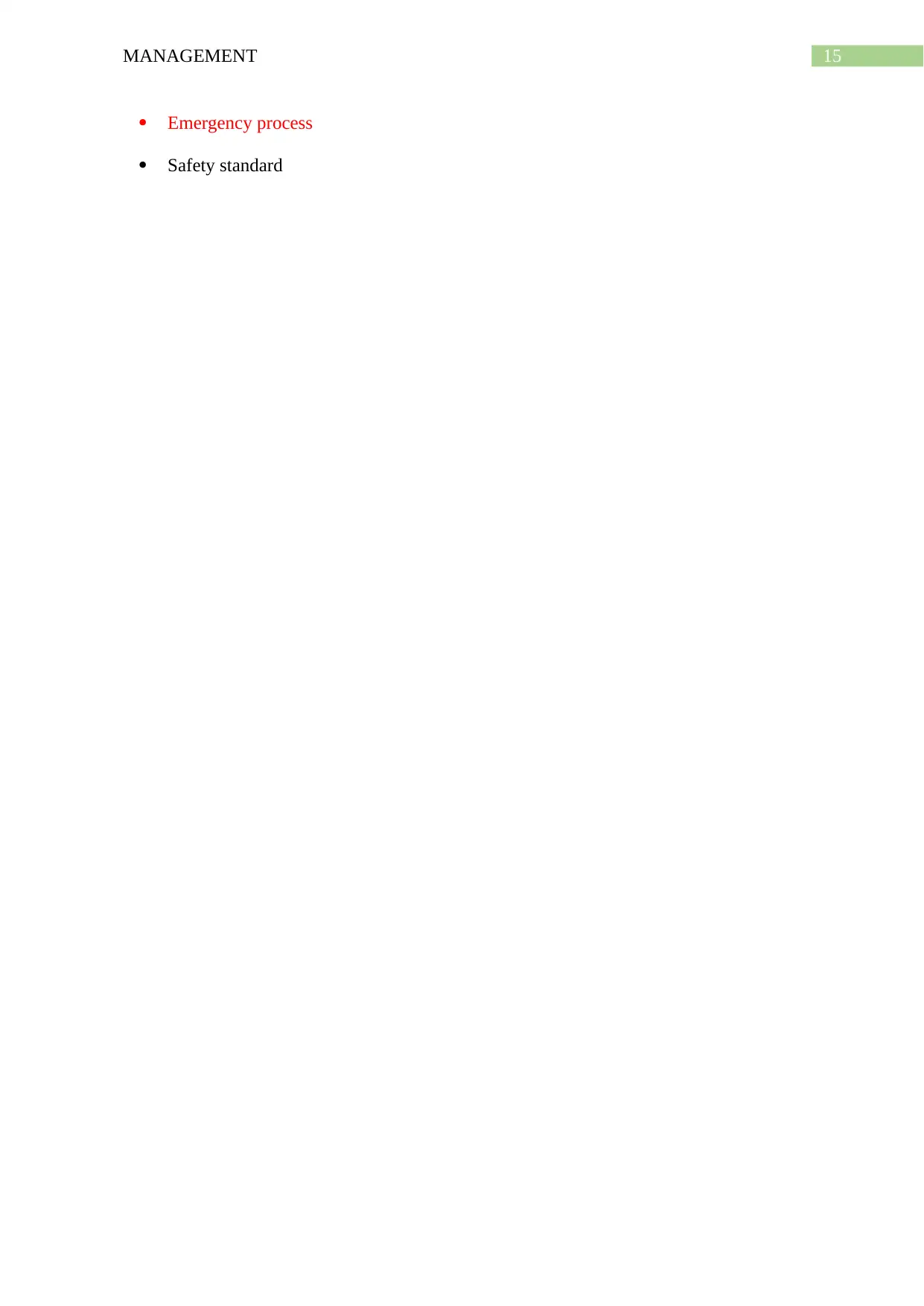
15MANAGEMENT
Emergency process
Safety standard
Emergency process
Safety standard
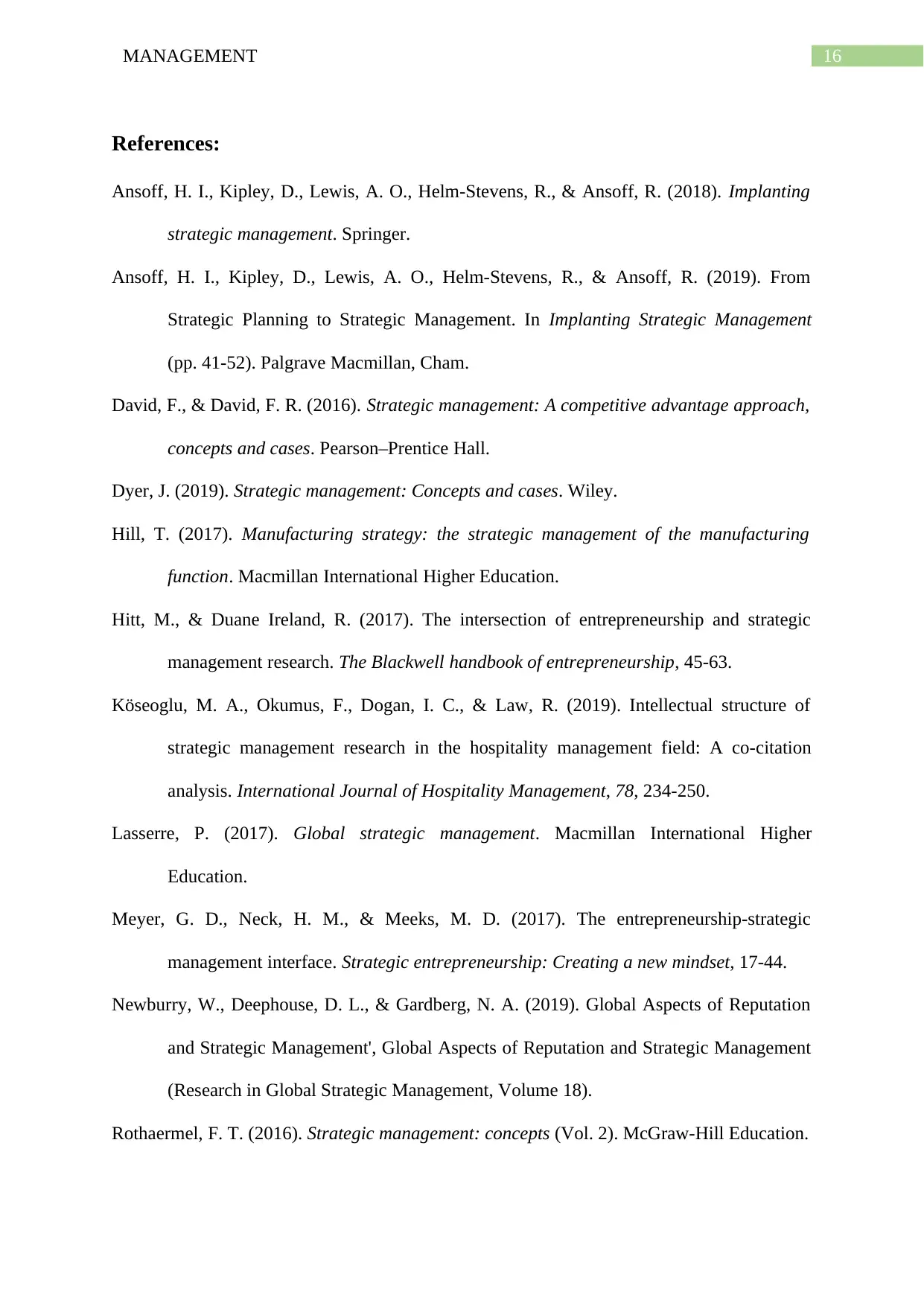
16MANAGEMENT
References:
Ansoff, H. I., Kipley, D., Lewis, A. O., Helm-Stevens, R., & Ansoff, R. (2018). Implanting
strategic management. Springer.
Ansoff, H. I., Kipley, D., Lewis, A. O., Helm-Stevens, R., & Ansoff, R. (2019). From
Strategic Planning to Strategic Management. In Implanting Strategic Management
(pp. 41-52). Palgrave Macmillan, Cham.
David, F., & David, F. R. (2016). Strategic management: A competitive advantage approach,
concepts and cases. Pearson–Prentice Hall.
Dyer, J. (2019). Strategic management: Concepts and cases. Wiley.
Hill, T. (2017). Manufacturing strategy: the strategic management of the manufacturing
function. Macmillan International Higher Education.
Hitt, M., & Duane Ireland, R. (2017). The intersection of entrepreneurship and strategic
management research. The Blackwell handbook of entrepreneurship, 45-63.
Köseoglu, M. A., Okumus, F., Dogan, I. C., & Law, R. (2019). Intellectual structure of
strategic management research in the hospitality management field: A co-citation
analysis. International Journal of Hospitality Management, 78, 234-250.
Lasserre, P. (2017). Global strategic management. Macmillan International Higher
Education.
Meyer, G. D., Neck, H. M., & Meeks, M. D. (2017). The entrepreneurship‐strategic
management interface. Strategic entrepreneurship: Creating a new mindset, 17-44.
Newburry, W., Deephouse, D. L., & Gardberg, N. A. (2019). Global Aspects of Reputation
and Strategic Management', Global Aspects of Reputation and Strategic Management
(Research in Global Strategic Management, Volume 18).
Rothaermel, F. T. (2016). Strategic management: concepts (Vol. 2). McGraw-Hill Education.
References:
Ansoff, H. I., Kipley, D., Lewis, A. O., Helm-Stevens, R., & Ansoff, R. (2018). Implanting
strategic management. Springer.
Ansoff, H. I., Kipley, D., Lewis, A. O., Helm-Stevens, R., & Ansoff, R. (2019). From
Strategic Planning to Strategic Management. In Implanting Strategic Management
(pp. 41-52). Palgrave Macmillan, Cham.
David, F., & David, F. R. (2016). Strategic management: A competitive advantage approach,
concepts and cases. Pearson–Prentice Hall.
Dyer, J. (2019). Strategic management: Concepts and cases. Wiley.
Hill, T. (2017). Manufacturing strategy: the strategic management of the manufacturing
function. Macmillan International Higher Education.
Hitt, M., & Duane Ireland, R. (2017). The intersection of entrepreneurship and strategic
management research. The Blackwell handbook of entrepreneurship, 45-63.
Köseoglu, M. A., Okumus, F., Dogan, I. C., & Law, R. (2019). Intellectual structure of
strategic management research in the hospitality management field: A co-citation
analysis. International Journal of Hospitality Management, 78, 234-250.
Lasserre, P. (2017). Global strategic management. Macmillan International Higher
Education.
Meyer, G. D., Neck, H. M., & Meeks, M. D. (2017). The entrepreneurship‐strategic
management interface. Strategic entrepreneurship: Creating a new mindset, 17-44.
Newburry, W., Deephouse, D. L., & Gardberg, N. A. (2019). Global Aspects of Reputation
and Strategic Management', Global Aspects of Reputation and Strategic Management
(Research in Global Strategic Management, Volume 18).
Rothaermel, F. T. (2016). Strategic management: concepts (Vol. 2). McGraw-Hill Education.
Secure Best Marks with AI Grader
Need help grading? Try our AI Grader for instant feedback on your assignments.
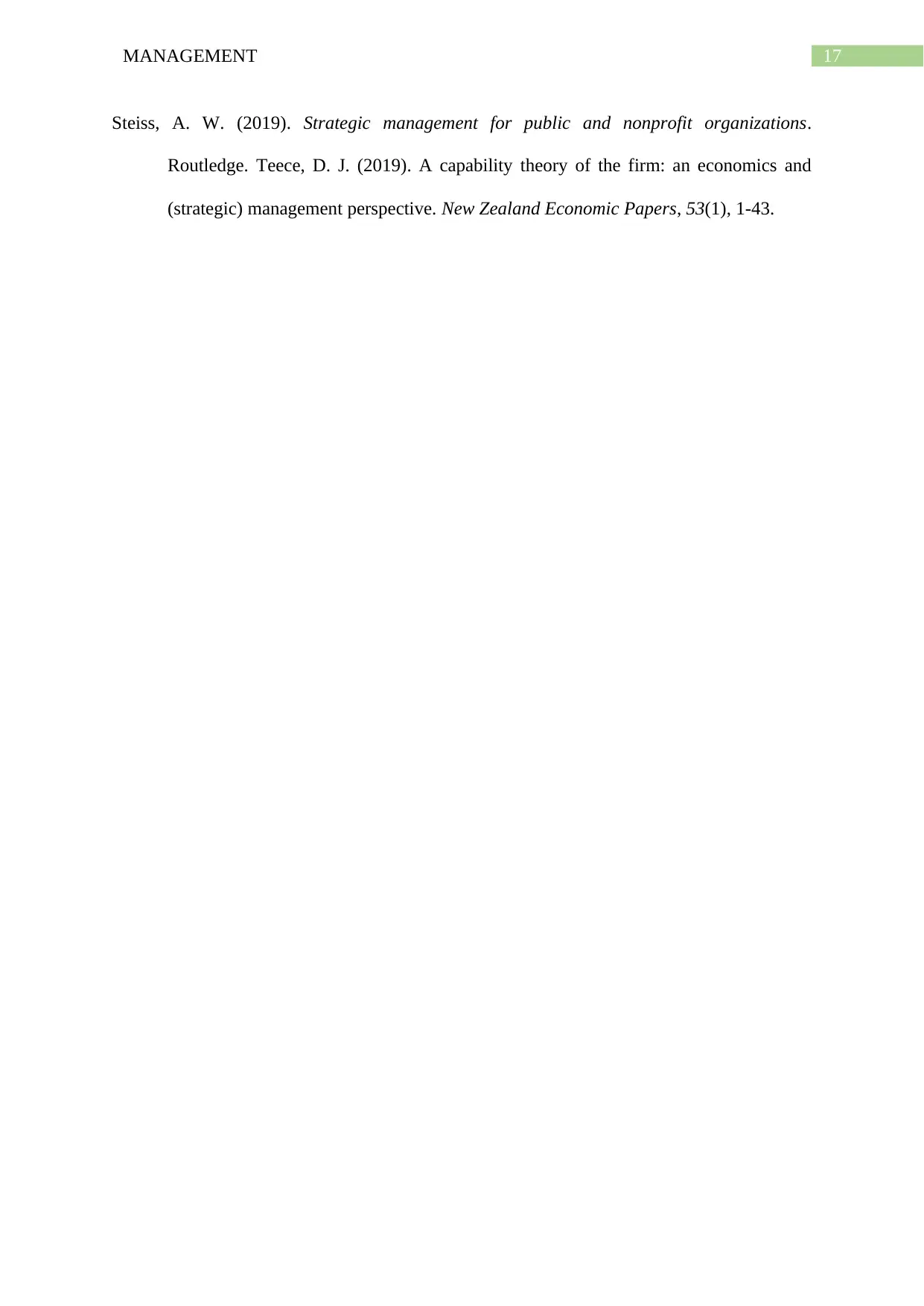
17MANAGEMENT
Steiss, A. W. (2019). Strategic management for public and nonprofit organizations.
Routledge. Teece, D. J. (2019). A capability theory of the firm: an economics and
(strategic) management perspective. New Zealand Economic Papers, 53(1), 1-43.
Steiss, A. W. (2019). Strategic management for public and nonprofit organizations.
Routledge. Teece, D. J. (2019). A capability theory of the firm: an economics and
(strategic) management perspective. New Zealand Economic Papers, 53(1), 1-43.
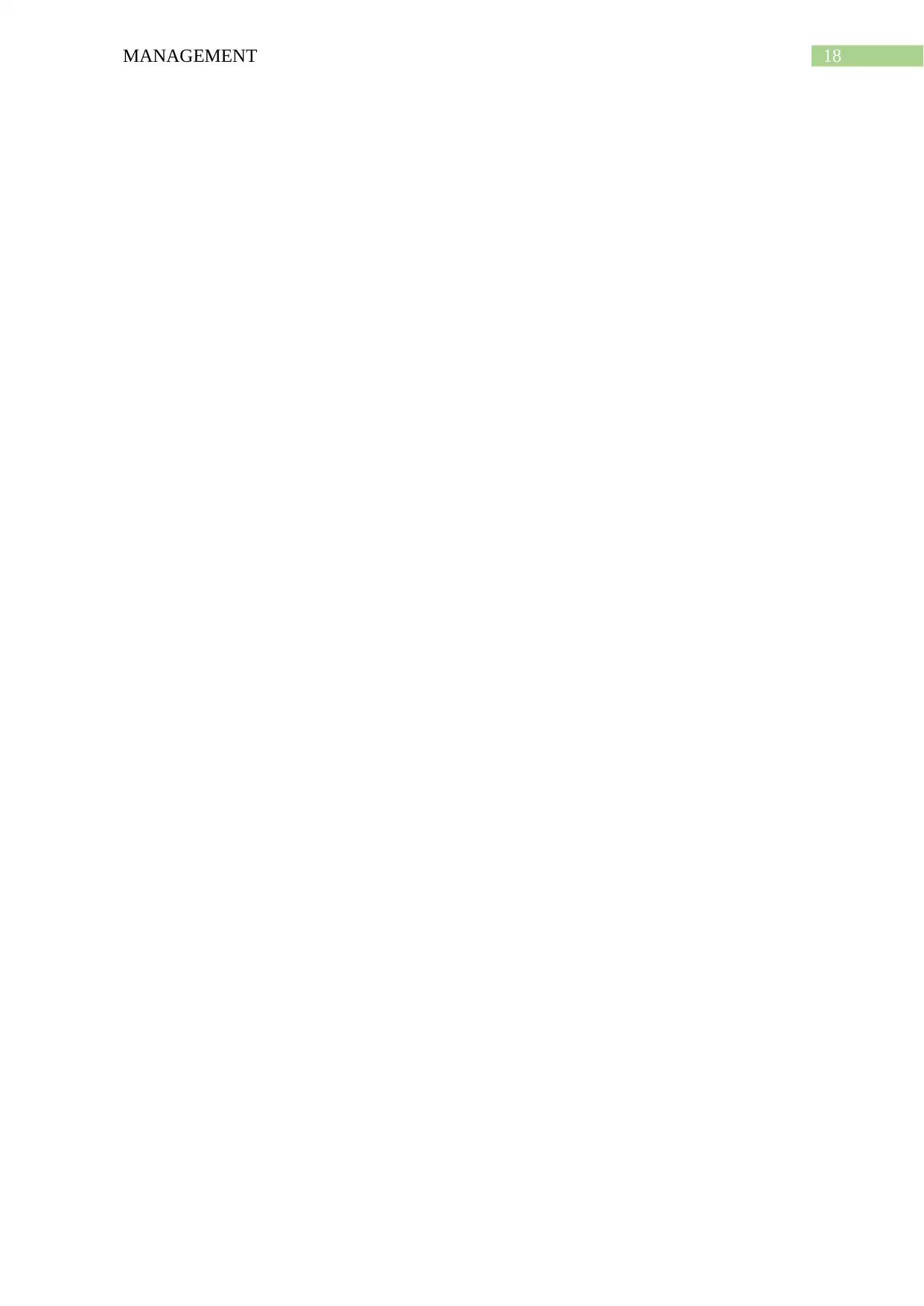
18MANAGEMENT
1 out of 18
Related Documents
Your All-in-One AI-Powered Toolkit for Academic Success.
+13062052269
info@desklib.com
Available 24*7 on WhatsApp / Email
![[object Object]](/_next/static/media/star-bottom.7253800d.svg)
Unlock your academic potential
© 2024 | Zucol Services PVT LTD | All rights reserved.





